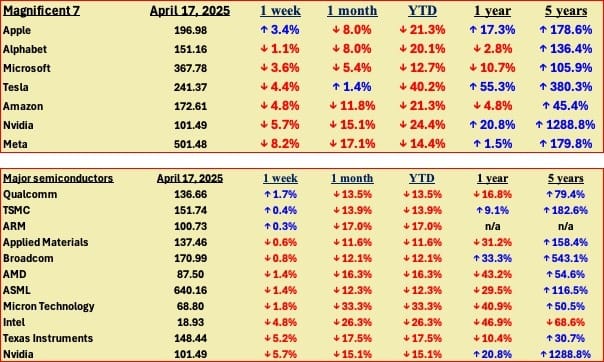INSIGHT WEEKLY: April 20, 2025
📩 Images not loading? Click “Download external images” or read the full magazine online via the link above.
⏳ 5 minutes reading time. Stay ahead without the overload.
500+ professionals have subscribed to this magazine.

🌐 Markets Overview

📈 Markets This Week: Rally, Reprieve, or Reset?

Markets took investors on another bumpy ride this short week. Many markets were closed on Friday.
The S&P 500 and Nasdaq both slipped for a second straight week, weighed down mostly by weakness in the big tech names that had been leading for so long.
But it wasn’t all bad news as smaller and mid-sized companies held up better with the Russell 2000 up 2.7%.
Meanwhile, Europe saw a bit more optimism. Stocks there posted gains after the European Central Bank signaled it’s still planning to cut rates in the months ahead. A temporary pause in new U.S. tariffs on European goods added to the relief rally.
Japan’s markets also moved higher, helped by steady monetary policy signals and a little more optimism around U.S.-Japan trade talks.
Political uncertainty and earnings concerns remain predominant.
A major shift has started in the bond market — and here’s why:
Over the last few weeks, yields have been going up as bond prices have gone down (Yields and bond prices move in opposite directions).
The big picture view:
Tariffs will bring more inflation into the US economy, which will need to be combated by higher interest rates.
US Treasuries are becoming less attractive as a safe haven asset, as gold increasingly fulfils that role.
Overall, US markets are becoming less attractive to investors, and we have seen equities, Treasuries, and the dollar falling together.
Some countries are building non-dollar frameworks. For example, Russia and China settling energy trades in both dollars and yuan, China and Brazil announced they would conduct bilateral trade directly in yuan and Brazilian reais, ASEAN De-Dollarization initiatives to settle in local currencies, Saudi Arabia signaling yuan oil pricing for sales to China, BRICS common currency discussions, which are still at an early stage.
2025 deficit is expected to be $2 trillion and will become additional debt.
Previous debt of about $8 trillion needs to be refinanced in 2025 and 2026. Most of this debt originated in the low-interest-rate era of 2020 to 2022, and will need to be refinanced at much higher rates.
Alert - conspiracy theory below:
There’s a conspiracy theory circulating that the U.S. government is actively engineering a recession to drive down interest rates and make it easier to refinance over $8 trillion of maturing debt. While there is no evidence for this in serious economic analysis, the scale of the upcoming refinancing has made debt sustainability a much more sensitive issue in policy discussions.
Regardless of the theory, the bond market is starting to react to the sheer weight of upcoming U.S. refinancing needs.
What will the Federal Reserve do? Fed Chair Jerome Powell made it clear that while inflation progress has been uneven, the central bank isn’t rushing to move interest rates one way or the other!
Tech stocks:
Tech giants faced new headwinds this week, from export curbs to cooling demand.
After last week’s rebound, another dip this week.

The tech sector remained volatile this week, with Nvidia and Tesla making the news for very different reasons.
Nvidia came under renewed pressure as U.S.-China tensions around technology exports escalated. The Trump administration imposed new export restrictions, requiring Nvidia to obtain licenses to ship its H20 AI chips to China with no grace period for outstanding orders. Nvidia warned of potential revenue losses of up to $5.5 billion from Chinese clients like Tencent, Alibaba, and ByteDance.
Nvidia’s top AI chips, the H100 and the newer H200, have already been banned from sale to China under earlier export restrictions.
Tesla continued to struggle with softer demand. Reports emerged that Tesla is cutting prices across major markets, including the U.S. and China, to maintain sales momentum. Margins are under pressure, and production slowdowns were rumored in some regions. Tesla’s stock declined again this week, and is now down 40% this year, reflecting concerns about profitability and competitive pressures, especially from Chinese EV makers.
🇺🇸 Tariffs and Game Theory: Strategic Moves Beneath the Surface
Tariffs are often seen as economic tools, but they are increasingly used to achieve political and strategic objectives beyond pure economics.
Game Theory can show why tariff disputes often unfold the way they do.
A classic model is the Prisoner’s Dilemma, where two players can either cooperate or act selfishly. While cooperation would deliver the best overall outcome, fear that the other side might break the agreement often pushes both toward imposing tariffs, resulting in losses on both sides, even when no one intended that outcome.
Trade tensions can also resemble a Chicken Game. Here, both sides escalate threats, hoping the other will concede first.
Another common dynamic is Tit-for-Tat. In repeated disputes, countries tend to mirror each other’s actions — tariffs are met with tariffs, concessions with concessions.
Finally, the broader framework of Zero-Sum versus Positive-Sum thinking shapes the approach to negotiations. A zero-sum mindset views one country’s gain as another’s loss, driving protectionist instincts. A positive-sum view sees trade as an opportunity for mutual benefit, encouraging collaboration instead of escalation.
✈️ For Travellers, Nomads, Freelancers & Global Professionals
I’ve used Wise for years to manage money across borders. It’s one of the few financial tools that truly gets international life right.
With Wise, you can:
Hold and convert 40+ currencies in one account
Send and receive money with the mid-market exchange rate with no hidden markups
Get local account details in major currencies:
GBP, USD, EUR, AUD, NZD, SGD, CAD, JPY, THB, VND, and more
Spend globally using the Wise debit card with no foreign transaction fees
(Affiliate link — using this link costs you nothing extra compared to going directly to Wise, but it helps support Insight Weekly.)
🧭 Macro Watch: This Week’s Economic Developments
Here’s a quick roundup of this week’s key economic developments across major economies.
🇺🇸 United States
Economic data remained mixed. Retail sales for March beat expectations, suggesting consumer strength, but inflation concerns persisted after higher-than-expected producer price readings.
Federal Reserve Chair Jerome Powell signaled that the central bank is likely to keep rates higher for longer, with no near-term plans to cut. Markets now expect fewer rate cuts in 2025 than previously priced.
🇪🇺 Europe
Inflation pressures continued to ease across the Eurozone, with core CPI moving slightly lower. ECB officials, however, remained cautious, signaling that rate cuts could begin as early as summer but would depend on incoming data. Germany’s economic sentiment showed modest improvement, although broader growth indicators remain sluggish
🇯🇵 Japan
The yen strengthened modestly as safe-haven flows picked up amid global market volatility. No major economic releases were published this week, but policymakers are watching carefully as import prices stabilize and wage growth holds firm. Markets continue to expect a gradual, cautious tightening path from the Bank of Japan after last month’s exit from negative interest rates.
🇨🇳 China
China reported better-than-expected first-quarter GDP growth at 5.2%, but trade figures remained soft, highlighting external demand challenges. Beijing announced additional modest stimulus measures aimed at supporting the property sector and consumer spending.
🇮🇳 India
Inflation eased slightly in March, offering the Reserve Bank of India more room to maintain its supportive stance. Industrial production surprised to the upside, reinforcing expectations for steady economic momentum heading into mid-2025. India continues to position itself as a relative safe haven among emerging markets.
If you like this newsletter, please send this link to friends, family, and colleagues and post it on social media. https://insight-weekly.beehiiv.com/subscribe
🌐 Artificial Intelligence and Tech

This cover has been designed using assets from Freepik.com
Google DeepMind unveiled “Lyria,” a new AI model capable of generating music from text prompts. Lyria is now available in preview through Google’s Vertex AI platform, opening fresh possibilities for creative industries. This has raised both excitement and questions about the future of artistic production.
Huawei announced a major AI hardware breakthrough this week, unveiling a new accelerator chip designed to rival Nvidia’s dominance in the high-end AI training market. Early benchmarks suggest Huawei’s new chip offers comparable performance to Nvidia’s H100, with potential advantages in energy efficiency and cost (Nvidia’s H100 is not permitted to be exported to China).
Nvidia announced a major expansion of its enterprise offerings this week with the launch of Cloud AI Workstations removing the need for expensive local infrastructure. This will improve access to advanced AI development tools.
Los Angeles has quietly established itself as one of America’s major tech hubs. The city now boasts over 6,000 tech companies and 37 unicorns, fueled by investments in AI, cloud computing, and cybersecurity. Venture capital activity has surged, and L.A.’s growing ecosystem is increasingly seen as a serious rival to traditional tech strongholds like Silicon Valley and New York. AI and entertainment technology are two of the city’s standout sectors.
Get your free guide to AI
🌐 Crypto Corner
Top 10 cryptos:

Bitcoin rallied over 5%, approaching the $84,000 mark, as market sentiment improved and volatility in traditional markets sent some investors back into digital assets.
Solana was the standout, surging more than 15%, fueled by growing interest in its decentralized finance (DeFi) and NFT ecosystems.
Ethereum also posted solid gains of 4%, although it is down over 50% this year as DeFi usage and NFT transaction volumes declined significantly compared to the 2021–2022 boom years.
The stabilization in Bitcoin dominance suggests that while the risk appetite for altcoins has returned, Bitcoin remains the anchor for market sentiment.
See the previous spotlight on Bitcoin halving
If you liked this newsletter, please send this link to friends, family, and colleagues and post on social media. https://insight-weekly.beehiiv.com/subscribe
Stay tuned for more insights and updates each week.